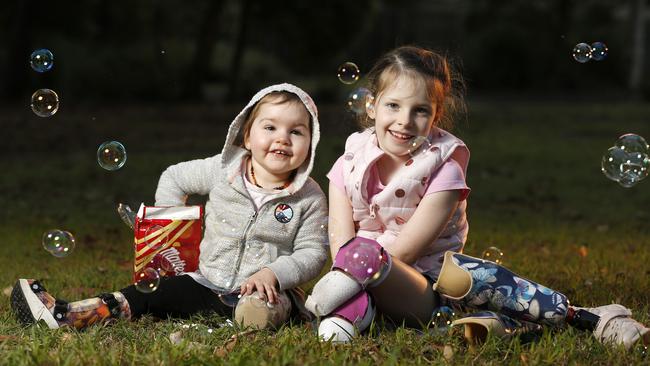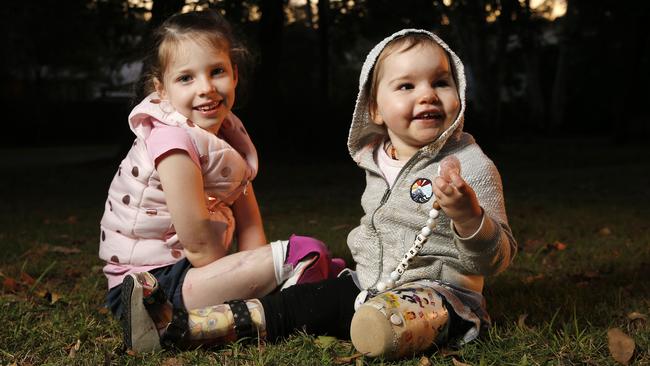Little Mia and Carrie’s stories of bravery a warning for others
Mia Wilkinson and Carrie Giles have been bonded by a disease that hits healthy children without warning, leaving many maimed and ripping away the life of others. Now their mums want to let others know how to spot the deadly disease that changed their lives forever.
QLD News
Don't miss out on the headlines from QLD News. Followed categories will be added to My News.
GIGGLES are not in short supply when you put together two of Queensland’s most resilient little girls.
Mia Wilkinson, 7, and Carrie Giles, who is not yet three, have been bonded by the thunderbolt that is sepsis – a sneaky disease that hits healthy children without warning leaving many maimed and ripping away the life of others.
Five-year-old sepsis survivor Mia Wilkinson gets new mermaid legs
How a bubbly five-year-old bounced back after sepsis took her arms and legs
The loss of limbs have connected their families in a way no one could ever have predicted.
In 48 hours Mia went from being a healthy, happy child to being on life support.
She is now a quadruple amputee and losing her limbs was the only way to keep her alive. Carrie had to lose her heavily infected leg to help her kidneys recover.

Both their parents have shared the paralysing fear of watching and praying for the next breath in ICU, and now Mia has taken Carrie under her wing.
Carrie’s nightmare all started as a simple cough. For Mia it was flu-like symptoms. But within days their little bodies were covered in horrific mottled purple rashes – the deadly signs all over their skin.
Now, as life goes on and the sunny smiles have returned to these amazing kids, both mums want Queensland parents to know about sepsis.
“I had never heard of sepsis and I wasn’t prepared for the trauma,” Liz Giles said.
Amy Wilkinson asked if daughter Mia could have meningococcal but sepsis was an unknown. Sepsis is a serious infection that causes the immune system to attack the body, often shutting down organs.
But today in Queensland, moves are being made to educate mums and dads about the early signs of this frightening disease.

Queensland’s Amanda Harley is Australia’s first dedicated paediatric sepsis clinical nurse consultant (CNC) and she sees first-hand the devastation caused by sepsis in the state’s emergency wards.
Queensland Children’s Health runs the Queensland Paediatric Sepsis Pathway, a screening tool for the early recognition and treatment of paediatric sepsis in a time-critical emergency.
“We have education pathways within the hospitals for clinicians but we realise that mums and dads are often the experts in their own kids and it is important to get the children medical attention as soon as possible so Queensland Health is planning a community education pathway to spread the word,” Ms Harley said.
“The plan is to hit schools, GPs, universities and rural and remote areas.”
The earlier a child is treated the better chance of a positive outcome.
“It’s not an easy thing to identify as it hits suddenly and can be disguised as a cold or flu but if a parent has a gut feeling that something is badly wrong they can ask the question ‘could it be sepsis?’,” Amy said.
“The hospitals are doing a great job in fighting sepsis but the community needs to be involved to help save our children,” she said.
Amy says Mia, who received new prosthetic legs in 2018 thanks to The Courier-Mail’s Children’s Fund, enjoys time spent with little Carrie.
“They have a special connection but I too need the bond with other parents who understand the rollercoaster of having a child hit so suddenly with a potentially deadly disease,” she said.
“Only other parents who have lived through that can understand.
“Mia is only seven and really just wants to be with her peers but I think when she is older she will want to connect more with people who live the same struggles. But right now little girls like her and Carrie just want to have fun.”
DID YOU KNOW?
■ 55,000 Australians had sepsis in 2017
■ 8700 died, including children, in 2017
■ 40 per cent of cases are under-5s
■ Hundreds in ICU each year
■ Third of survivors have lifelong problems
■ Numbers are rising
■ Kills more people than road accidents and many cancers
■ Signs of sepsis in kids: Rapid breathing, convulsions, pale or bluish skin, rash that doesn’t fade when pressed, fever or very low temperature, no urine, not feeding, vomiting repeatedly, floppy.

